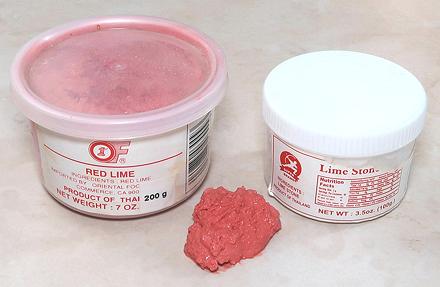 [Pun daeng (Thai, red); Calcium Hydroxide, (Ca(OH)2)]
[Pun daeng (Thai, red); Calcium Hydroxide, (Ca(OH)2)]
Lime is used in Thailand to produce crisper, longer lasting batters on fruits and other deep fried items. It is also used in pickling, and has long been so used in the West, to make pickles more crisp.
Use for pickling is no longer recommended. If the cucumbers are not very thoroughly washed after treatment, it can result in botulism infection, often resulting in death. The cause is decreasing the acidity of the pickling liquid.
This lime can be found in pink and white versions. The traditional pink color comes from it's use in Betel chews, an addictive, and probably carcinogenic, stimulant. The color comes from addition of Turmeric.
More on Salts.
Lime Water should be stored in a tightly sealed glass jar, with the solids still in the bottom. It will last for many years. Left undisturbed, little floating white bits will form on the surface. Lacking these, the Lime Water is not strong enough and more lime must be added. Another test is to shake it up. If the solids sink to the bottom immediately, the water is too weak. They should float down.
sa_limez. 200319 - www.clovegarden.com